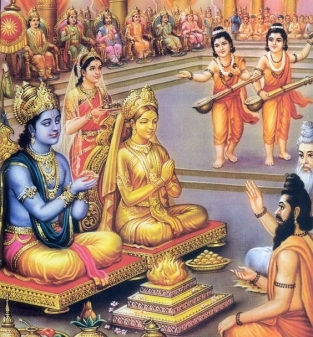Not much surprising enough, Indian literature in English and its historical evolvement had happened alongside the consolidation of British imperialism in India. There however exists a variety of opinion about the first definitive Indian text in English, although critics come to the agreement that history of Indian English literature dates back to at least the early 19th century. Its beginnings had received their impetus from three sources - the British government's educational reforms, the endeavour of missionaries and, the response and acceptance of English language and literature by upper-class Indians. First, there were the educational reforms called forth by both the Charter Act of 1813 and the 1835 English Education Act of William Bentinck. In an endeavour to rectify and equalise some of the materialistic and ravenous, hence compromising, practices of the East India Company servants, the English Parliament had approved the Charter Act, which had made England responsible for the educational betterment of the natives. The subsequent English Education Act, prompted by Thomas Babington Macaulay's ill-famed "minute" on Indian education, made English the medium of Indian education and English literature a disciplinary subject in Indian educational institutions.
Indian English Literature has matured from a sapling to a firmly rooted tree that blooms with its entirety still awaiting its yet-to-come metamorphosis. Indians, however, did not take to penning in English in a day - it took umpteen historical events and illustrious and notable personalities to bring Indian writing in English to its contemporary eminence. The basic historical perspective of English Indian literature is an effort to contextualise the growth and rise of this genre - from its inception to its present-day glory. Indian literature in English however possesses a relatively recent history; it is actually only one and a half centuries old. History of Indian English literature enlightens readers that the first book written by any Indian in English was by Sake Dean Mahomet, titled Travels of Dean Mahomet; Mahomet's travel treatise was published in 1793 in England. In its early stages, the narration was influenced by the Western art form of the 'novel'. Early Indian writers made thorough use of unadulterated English by Indian words to communicate an experience and understanding which was fundamentally and in essence, Indian.
In the contemporary Indian scenario, the country possesses a sizeable number of populace that has English as either primary or secondary language of means of communication. This is precisely because India had once served as a colony of the then British Empire, for close to 200 years, thus calling for a very precise and exact solid reason for history of Indian English literature and its consistent blooming. However, India's association with the British and hence English is even older. It is now a universally acknowledged fact that Mughal Emperor Jahangir had granted William Hawkins licence to trade in India in the year 1608 and that was when the English had placed its first step upon the Oriental soil. In the due course of history, British concluded their conquest of India in a triumphant and scheming manner. Thus, the distribution of English language along with the Empire in India was not quite a bolt from the blue, but rather a much expected aspect. English replaced Persian as the court language in early 19th century and interpreting and relating to English became a matter of survival for the urban class rather than a matter of conceit. As a new block of population began to emerge from the grass-roots, English language spread its wings and together with it, English literature in India also began to gather its gradual historical ripening.
Most of the early exponents of English Literature in India were however British, which is yet again, not surprising, because back then India was perhaps not in a state under British domination to reproduce native English brilliancy. On the other hand, leaving some of the much later Indian exponents, history of Indian English literature belonged solely to the socialite British class. The likes of George Orwell, Rudyard Kipling and Jim Corbett had lent the preliminary push (although in the indeed initial and budding times of Indian English literature, these men themselves were quite abhorrent of native living and style of possibly everything) that was later carried on by several British authors. Rabindranath Tagore, Michael Madhusudan Dutt, Rishi Aurobindo Ghosh, Jawaharlal Nehru and Sarojini Naidu who contributed much profoundly to the historical maturation of English literature in India, initially had represented the natives, serving as the pre-Independent mouthpiece to these hapless men. But it was only in the mid nineteen seventies that a new breed of 'boarding-school educated', elite brand of Indian English authors started to rise forth on the global radar. These lent the much-needed life blood to English literature with their crisp, bantering yet subtly humorous and realistic fictions that were devoured all over the world.
The history of English language and literature in India all starts with the advent of the East India Company (an English company established and formed to develop trade with the new British colonies in India and south-eastern Asia) in India. The East India Company was formed in 1599, at a meeting participated by leading London merchants and after more than 150 years, the Company held the key to the domination of Bengal and India in general. The Battle of Plassey was fought in 1757, but Lord Clive had refused the liability of Diwani or revenue administration and it was in 1722 that the East India Company took over its duty. And still later, precisely in 1790, the liability for administering criminal justice was also bestowed upon the Company. The Company was, however, interested in political authority and supremacy only to the degree that such supremacy would manifold and multiply its own dividends. It was directly interested neither in Empire building nor in the 'Kingdom of Christ' - and certainly not in the repression or augmentation of indigenous culture. But here existed exceptions as well. Warren Hastings had established the Calcutta Madrasah in 1781, Sir William Jones had established the Royal Asiatic Society of Bengal in 1784 and Sir Thomas Munro too was much bemused and stupefied by the Indian ancient cultural wonders. These men came to be renamed as the 'Brahmanised Britons', because they admired Indian culture and strongly disapproved the idea of introducing Western civilisation or Christianity into India in any form.
By the commencement of the 19th century, Britain - or East India Company - was more or less the master of the situation in India. In 1813, the commercial monopoly of the Company was lent a curtain call and the British in India acquired, beside police functions, educating and civilising deputation as well. History of English literature in India, had by this time, taken much gigantic proportions, with the nascent buds beginning to bloom in a yet unsure direction. However, in such a context, a token grant of rupees one lakh per year was granted for education and the proposal was to promote only Oriental education. Printing presses in different parts of the country and books in the vernacular language as well as in English were begun to be issued since the beginning of the 18th century. Together with grammars, dictionaries and translations, the printing presses also brought out the first ever newspaper - James Augustus Hickey's Bengal Gazette (1780) and others came after in due course. Last to arrive in the illustrious history of Indian English literature, were the private schools that imparted English education. Such schools had been started as early as 1717 at Cuddalore near Madras, 1718 in Bombay (by Richard Cobbe, a chaplain) and 1720 in Calcutta, endowed by the Thomlinsons, closing in the establishment of Hindu College in 1817.
Begun by Raja Ram Mohan Roy and his friends - David Hare and Sir Edward Hyde East, the Hindu College had become the Presidency College in 1855, still recognised as one of the most premier educational institutes in Kolkata. Western education was fast being circulated in different parts of India and was performing much better than the institutions imparting oriental and indigenous education. The Orientalists and the Anglicists continued to bicker and squabble still, but it was quite apparent that the former were steadily losing ground and Lord Macaulay's celebrated 'Minute' decided the issue at last. History of English literature in India was thus gaining its higher grounds by being uplifted and rejuvenated under the still good-hearted Britishers, striving for excellence in the Indian native scenario. Macaulay had declared that it was obligatory, mandatory and possible to "make the natives of these country good English scholars and that to this end our efforts ought to be directed." On 7th March, 1835, Lord William Bentinck had also resolved that "the great object of the British Government ought to be the promotion of European Literature and science among the natives of India, and all funds appropriated for the purpose of education would be best employed on English education alone." From 1835 was thus ushered in the 'Anglicising Period' in the historical development of English literature for India. However, such an audacious British move was yet rather hanging in the midsection, with the natives yet to decide the upcoming ill-effects and malicious English domination, which could only be shovelled out in the mid 20th century.
During the 20 years between 1835 to 1855, the number of those enlightened in English were witnessed to increase rather rapidly and vociferously. It is known that even during 1834-35, 32,000 English books were sold in India, as against 13,000 in native Indian languages. Indian English literature and its history and evolutionary maturation was verily perceived when the craze for English books heightened. The demand however came more from the English educated Indian bunch as opposed to from the Englishmen in India. In 1853, the first railway was established in India, followed by the first telegraph line in 1854 and a modern postal system was also inaugurated to boost Indian English literature towards a successful historical exploitation. Distance was being gradually abbreviated and a common medium of communication was being demonstrated. Sophisticated European scientific techniques (incorporating medicine and surgery) were slowly being introduced in India. It was thus conceived that India was eventually progressing from its static and secure 'medievalism' to a vibrant 'modernism'.
Indians began with reading, speaking and apprehending English and they soon started writing also in such a 'foreign' medium. Once this was ushered in, the history of Indian writing in English began to range from the most useful and functionary prose to the most motivated and determined verse-epics, for instance. On the other hand, Indian writing in English was but only one of the materialisations and expressions of the new creative impulse in India - what is often referred to as the 'literary Renaissance in India'. The study of English literature as can be seen historically, had energised and perked literary creations in Bengali, Marathi, Telegu, Gujarati and other various Indian languages. And Indo-Anglian literature possessed the same origin as the other modern literature in India, although here the foreign factor seemed more noticeable and marked. And in this context, the two distinct categories of Indian English literature during British India and Post-colonial Indian English literature came to the surface, perfectly mirroring the pre-Independent and post-Independent society.
More readings related to Indian literature:-
 are instrumental in narrating the entire Sanskrit epic. Most of the characters like Lord Rama, Sita, Lakshmana, Hanuman and others are considered as deities according to Hindu mythology.
are instrumental in narrating the entire Sanskrit epic. Most of the characters like Lord Rama, Sita, Lakshmana, Hanuman and others are considered as deities according to Hindu mythology. Lord Rama: He was the son of King Dasaratha and Queen Kausalya. He was the prince of Ayodya. He is an ‘avatara’ of Lord Vishnu and was married to Sita.
Lord Rama: He was the son of King Dasaratha and Queen Kausalya. He was the prince of Ayodya. He is an ‘avatara’ of Lord Vishnu and was married to Sita. Sita: She was the daughter of Mother Earth adopted by King Janaka. Sita married Lord Rama, and she is also regarded as an ‘avatara’ of the Goddess Lakshmi.
Sita: She was the daughter of Mother Earth adopted by King Janaka. Sita married Lord Rama, and she is also regarded as an ‘avatara’ of the Goddess Lakshmi. Ravana: Ravana was a devil who performed penance for a long time until Lord Brahma appeared before him and granted him a boon.
Ravana: Ravana was a devil who performed penance for a long time until Lord Brahma appeared before him and granted him a boon.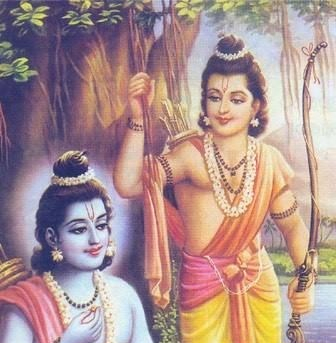 Lakshmana: He was the son of King Dasaratha and Queen Sumitra. He was dedicated to his brother and followed him throughout many adventures and hunts. He is ascribed as the incarnation of ‘Ananta Sesha’, the 1000 headed Naga.
Lakshmana: He was the son of King Dasaratha and Queen Sumitra. He was dedicated to his brother and followed him throughout many adventures and hunts. He is ascribed as the incarnation of ‘Ananta Sesha’, the 1000 headed Naga. King Dasaratha: Dasaratha was the emperor of Ayodhya, father of Lord Rama, Lakshmana, Bharata, and Shatrughna.
King Dasaratha: Dasaratha was the emperor of Ayodhya, father of Lord Rama, Lakshmana, Bharata, and Shatrughna. Bharata: He is famous for his love and devotion towards his elder brother Lord Rama.
Bharata: He is famous for his love and devotion towards his elder brother Lord Rama. Lord Hanuman: He was the advisor of Sugriva. He was the son of Anjana and Kesari and he is believed to be an avatar of the supreme Lord Shiva. He was a guardian spirit, the offspring of a nymph and the Wind God.
Lord Hanuman: He was the advisor of Sugriva. He was the son of Anjana and Kesari and he is believed to be an avatar of the supreme Lord Shiva. He was a guardian spirit, the offspring of a nymph and the Wind God.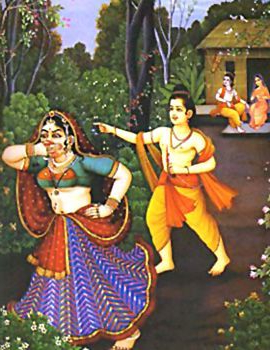 Surpanakha: She was the sister of Ravana who was a powerful demon. She tried to seduce Lord Rama and kill Sita, but Lakshmana attacked her.
Surpanakha: She was the sister of Ravana who was a powerful demon. She tried to seduce Lord Rama and kill Sita, but Lakshmana attacked her.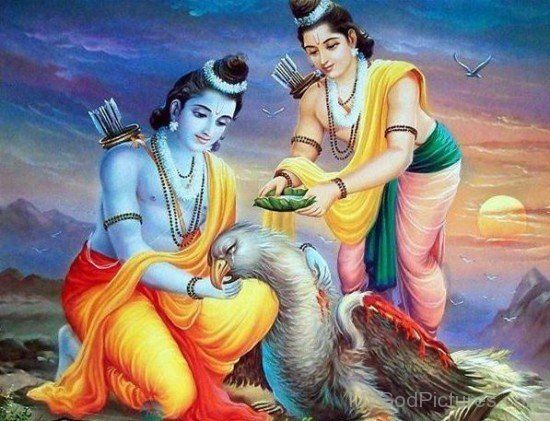 Jatayu: Jatayu was a powerful golden eagle who spoke in the voice of a human being. He died protecting Sita from Ravana.
Jatayu: Jatayu was a powerful golden eagle who spoke in the voice of a human being. He died protecting Sita from Ravana. Shravan Kumar: He was as a dedicated son who carried his blind parents on his shoulders for a pilgrimage tour.
Shravan Kumar: He was as a dedicated son who carried his blind parents on his shoulders for a pilgrimage tour. Kumbhakarna: He was Ravana's brother. He had a huge physique with unlimited strength. He used to sleep for six months at a time before waking up and eating everything he could see.
Kumbhakarna: He was Ravana's brother. He had a huge physique with unlimited strength. He used to sleep for six months at a time before waking up and eating everything he could see.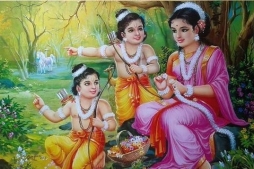 Lava: Along with Kusha, Lava was one of the student to whom Valmiki taught the Ramayana which he received from Narada. Lava was the king of Sriwasti, in northern Kosala. He was the founder of the city of Lahore, which is named after him.
Lava: Along with Kusha, Lava was one of the student to whom Valmiki taught the Ramayana which he received from Narada. Lava was the king of Sriwasti, in northern Kosala. He was the founder of the city of Lahore, which is named after him.